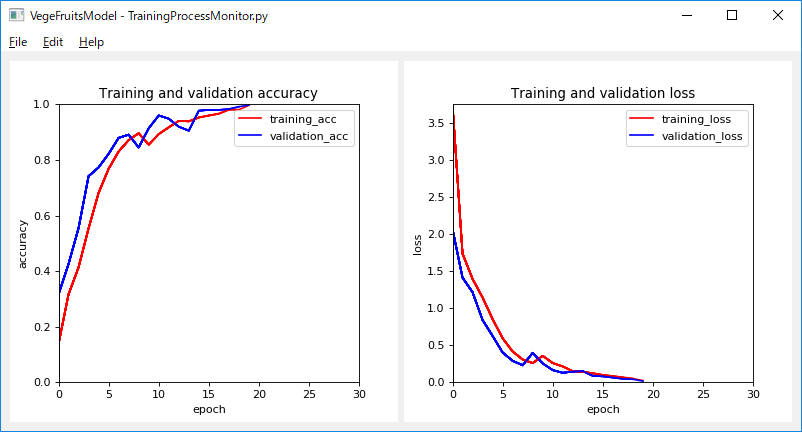|
SOL4Py Sample: TrainingProcessMonitor
|

The above figure of 'TrainingProcessMonitor' is generated by the following model:
VegeFruitsModel
#******************************************************************************
#
# Copyright (c) 2018-2019 Antillia.com TOSHIYUKI ARAI. ALL RIGHTS RESERVED.
#
# This program is free software: you can redistribute it and/or modify
# it under the terms of the GNU General Public License as published by
# the Free Software Foundation, either version 3 of the License, or
# (at your option) any later version.
#
# This program is distributed in the hope that it will be useful,
# but WITHOUT ANY WARRANTY; without even the implied warranty of
# MERCHANTABILITY or FITNESS FOR A PARTICULAR PURPOSE. See the
# GNU General Public License for more details.
#
# You should have received a copy of the GNU General Public License
# along with this program. If not, see <http://www.gnu.org/licenses/>.
#
#******************************************************************************
# 2019/05/10
# TrainingProcessMonitor.py
#
import sys
import signal
import numpy as np
import traceback
import matplotlib
import matplotlib.pyplot as plt
import seaborn as sns
import pandas as pd
import threading
import time
from numpy.random import rand
sys.path.append('../')
from SOL4Py.ZApplicationView import *
from SOL4Py.ZPlottingArea import *
from SOL4Py.keras.ZEpochLogServer import *
class MainView(ZApplicationView):
## Inner class starts.
class EpochLogServer(ZEpochLogServer):
##
# Constructor
def __init__(self, view, ipaddress, port):
ZEpochLogServer.__init__(self, ipaddress, port)
# The values loss and acc may be plotted on figure of matplotlib
self.view = view
self.clear()
def clear(self):
print("clear")
self.x = []
self.y_loss = []
self.y_acc = []
self.y_val_loss = []
self.y_val_acc = []
self.max_loss = 3
self.x.append(0.0)
self.y_loss.append(0.0)
self.y_acc .append(0.0)
self.y_val_loss.append(0.0)
self.y_val_acc .append(0.0)
self.update_accuray_plotting()
self.update_loss_plotting()
#
def request_handle_callback(self, bytes, writer):
print(__class__.__name__ + "::" + __class__.request_handle_callback.__name__ + " start")
text = bytes.decode("utf-8")
print(text)
if "on_train_begin" in text:
if ":" in text:
_, notifier, epochs = text.split(":")
self.view.set_filenamed_title(notifier)
self.view.update_epochs(int(epochs))
self.clear()
if "," in text:
epoch, loss, acc, val_loss, val_acc = text.split(",")
print("{} {} {} {}".format(loss, acc, val_loss, val_acc))
self.x.append(int(epoch))
self.y_loss.append(float(loss))
self.y_acc .append(float(acc))
self.y_val_loss.append(float(val_loss))
self.y_val_acc .append(float(val_acc))
self.update_accuray_plotting()
self.update_loss_plotting()
def update_accuray_plotting(self):
self.view.update_plotter1(self.x, self.y_acc, 'red')
self.view.update_plotter1(self.x, self.y_val_acc, 'blue')
def update_loss_plotting(self):
v1 = self.max_loss
v2 = self.max_loss
if len(self.y_loss) > 1:
v1 = self.y_loss [np.argmax(self.y_loss)]
if len(self.y_val_loss) > 1:
v2 = self.y_val_loss[np.argmax(self.y_val_loss)]
print("loss v1:{} v2:{}".format(v1, v2))
max_loss = v1
if v2 > v1:
max_loss= v2
self.view.update_loss_max(max_loss)
self.view.update_plotter2(self.x, self.y_loss, 'red')
self.view.update_plotter2(self.x, self.y_val_loss, 'blue')
## Inner class ends.
##
# Constructor
def __init__(self, title, x, y, width, height, epochs=40, loss=3):
super(MainView, self).__init__(title, x, y, width, height)
self.epochs = epochs # epoch
self.stride = 1.0
self.accuracy = 1.0
self.loss = loss
plt.subplots_adjust(wspace=0.4, hspace=0.8)
# accuray_plotting
self.plotter1 = ZPlottingArea(self, width/2, height)
# loss_plotting
self.plotter2 = ZPlottingArea(self, width/2, height)
self.ax1 = self.plotter1.add(111)
self.ax1.set_title("Training and validation accuracy")
self.ax1.set_xlabel("epoch")
self.ax1.set_ylabel("accuracy")
self.ax2 = self.plotter2.add(111)
self.ax2.set_title("Training and validation loss")
self.ax2.set_xlabel("epoch")
self.ax2.set_ylabel("loss")
self.ax1.set_xlim(0, self.epochs)
self.ax1.set_ylim(0, self.accuracy)
self.ax2.set_xlim(0, self.epochs)
self.ax2.set_ylim(0, self.loss)
self.add(self.plotter1)
self.add(self.plotter2)
self.show()
# Create a thread and start it.
self.thread = self.EpochLogServer(self, ipaddress = "127.0.0.1", port= 7777)
self.thread.start()
def file_save(self):
try:
abs_current_path = os.path.abspath(os.path.curdir)
files_types = "PDF (*.pdf);;PGF (*.pgf);;PNG (*.png);;PS (*.ps);;EPS (*.eps);;RAW (*.raw);;RGBA (*.rgba);;SVG (*.svg);;SVGZ (*.svgz)"
filename, _ = QFileDialog.getSaveFileName(self, "FileSaveDialog",
os.path.join(abs_current_path, "figure.png"),
files_types)
if filename:
plt.savefig(filename)
except:
traceback.print_exc()
# Plotting training and validation accuracy
def update_plotter1(self, xs, ys, color):
self.ax1.plot(xs, ys, color=color, linestyle='solid')
self.ax1.legend(["training_acc", "validation_acc"])
self.plotter1.draw()
# Plotting training and validation_loss
def update_plotter2(self, xs, ys, color):
self.ax2.plot(xs, ys, color=color, linestyle='solid')
self.ax2.legend(["training_loss", "validation_loss"])
self.plotter2.draw()
def update_epochs(self, epochs):
self.epochs = epochs
self.ax1.set_xlim(0, self.epochs)
self.ax2.set_xlim(0, self.epochs)
def update_loss_max(self, loss_max):
self.ax2.set_ylim(0, loss_max)
def file_quit(self):
#print("file_quitt")
self.thread.close()
self.thread.join()
print("Thread stopped")
self.terminated = True
self.close()
def closeEvent(self, ce):
# Call file_quit to terminate self.thread
self.file_quit()
##############################################################
#
#
if main(__name__):
try:
name = sys.argv[0]
argc = len(sys.argv)
epochs = 40
loss = 3
if argc == 2:
epochs = int(sys.argv[1])
if argc == 3:
epochs = int(sys.argv[1])
loss = int(sys.argv[2])
applet = QApplication(sys.argv)
mainv = MainView(name, 40, 40, 800, 400, epochs= epochs, loss= loss)
mainv.show()
applet.exec_()
except:
traceback.print_exc()
else:
pass
finally:
pass
Last modified:20 Sep. 2019
